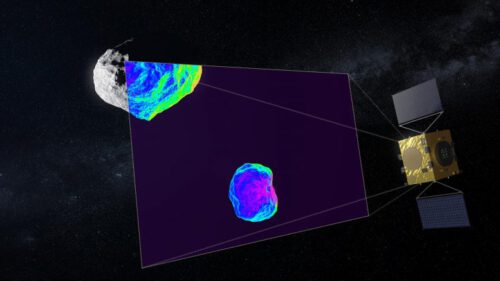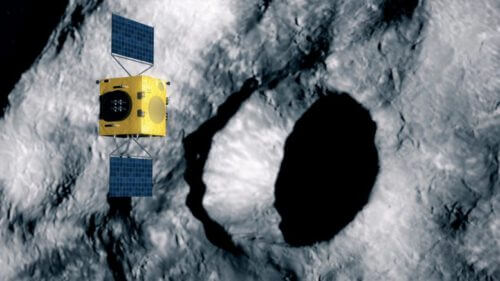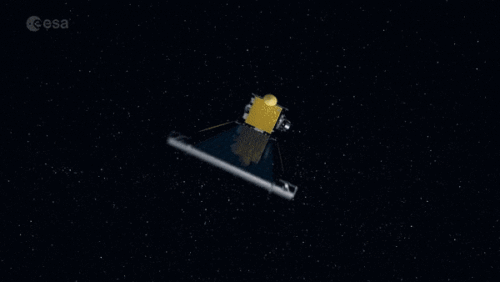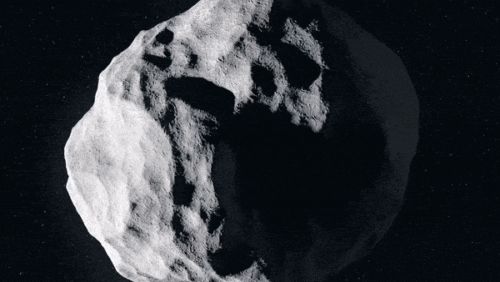ESA's ambitious Hera planetary defense mission awarded $153 million contract * Hera will fly to the asteroid that NASA's DART spacecraft will reach first and try to deflect its moon

Today the European Space Agency (ESA) awarded a $153 million contract that includes the detailed design, production and testing of Hera, the agency's first planetary defense mission. This ambitious task will be Europe's contribution to international activity for asteroid diversion, which is planned for ongoing exploration of a double asteroid system.
Hera – named after the Greek goddess of marriage – will, along with NASA's Double Asteroid Redirection Experiment (DART) spacecraft, be humanity's first probe to encounter a system of binary asteroids, a poorly understood type that makes up about 15% of all known asteroids.
The contract was signed today by Franco Ungro, ESA's director of technology, engineering and quality, and Marco Fuchs, CEO of the German space company OHB, the main contractor of the Hera consortium. The signing took place at the agency's Space Operations Center in Germany, which will serve as mission control for Hera to be launched in 2024.

Hera is Europe's contribution to international cooperation in planetary defense between American and European scientists called Asteroid Impact and Deflection Assessment (AIDA). The DART spacecraft - whose launch is planned for July 2021 - will first make a kinetic impact on the smaller of the two bodies. ESA will continue with a detailed post-impact survey to make this large-scale experiment a well-understood and repeatable asteroid deflection technique.
In doing so, Hera, which is about the size of a desk, will also demonstrate many new technologies, such as autonomous navigation around the asteroid – like modern driverless cars on Earth – while collecting vital scientific data to help scientists and planners of future missions better understand its composition and structure. of asteroids.

NASA's Double Asteroid Redirection Experiment (DART) mission is slated to collide with the smaller of the binary Didymus asteroid system's two bodies in fall 2022. ESA's Hera mission will then conduct post-impact follow-up observations.
Hera will also place in deep space Europe's first cubesats (tiny satellites made up of 10 cm cubes) that will perform close-up surveys of asteroids, including the first radar probe in the interior of an asteroid - using an updated version of the radar system carried by the Comet Rosetta mission of ESA.
Hera, whose launch is planned for October 2024, will fly to the binary asteroid system - the pair of asteroids closest to Israel Didymus. Around the main body, which is 780 meters in diameter and the size of a mountain, moves in a 160-meter lunar orbit, which was formally named Dimorphos in June 2020, about the same size as the Great Pyramid of Giza.

Hera's CubeSat Juventus approaches landing on Didymus' small asteroid.
DART's kinetic impact into Dimorphos in September 2022 is expected to change its orbit around Didymus and also create a large crater. This lunar asteroid will be unique, being the first celestial body to have its orbital characteristics and physics intentionally altered by human intervention. Hera will arrive in the Didymos system in late 2026, to perform at least six months of close-up exploration.
Hera's mission control will be at the agency's Space Operations Center in Darmstadt, Germany, which is also home to ESA's new Space Safety and Security Program, of which Hera is a part.
The signing of the contract includes all development, integration and testing of the Hera satellite, including its advanced guidance, navigation and control (GNC) system. The contracts for the two cubesats that Hera hosts and the development of the relevant technologies are already underway.
The European partners in Hara
The contract was awarded to a consortium led by the main contractor OHB System AG in Bremen.
Of the 17 ESA member states that contribute to Hera, Germany is at the forefront, and its mission is the overall design and integration of the Hera spacecraft, the main navigation cameras, tanks, engines, highly praised antenna, reaction wheels and memory management unit (MMU).
Italy Leads the mission's electrical and propulsion subsystems, and provides the deep space transmitter/receiver that will enable the mission's radio science experiment. In addition, Italy leads the CubeSat for the search for dust and minerals, named after the late Andrea Milani, a distinguished professor and leading asteroid scientist.
Belgium Develops the computer and software inside Hera, the brain of the space vehicle, plus the stabilization and power distribution unit - the heart of the electrical subsystem. It also contributes to the Hera thermal camera developed in Japan and the CubeSat Activity Center at ESA/ESEC.
Luxembourg Leads the CubeSat Juventus which hosts the radar and the intersatellite communication system that allows the two cubesats of Hera to communicate with the country through an innovative network that uses Hera as a data relay.
Portugal and Romania Developing the laser altimeter that will provide essential information for the autonomous navigation functions. Additionally, Rumania Develops the image processing unit, test application and electronic test equipment (and also contributes to the development of the GNC).
The Czech Republic Responsible for the entire structure of the satellite, the satellite software (to control the instruments), independent validation of the software and ground support equipment for pre-flight experiments of the satellite. It also provides components for the Juventus low frequency radar and data processing software for CubeSat II.
Spain Develops Hera's advanced guidance, navigation and control system as well as the communication system in deep space. It also supplies the Juventus gravity meter.
- Austria Supports by analyzing and processing the task's data.
- Denmark Contributes to Cubsat Juventus and the remote thermal unit.
- France Provides the Juventus low frequency radar, as well as star trackers and support for planning the operation of the satellites and the near orbits of the cubesats.
- Hungary Supports the scientific calibration of the cameras.
- Netherlands develops a system for deploying cubesats in deep space and supplies Hera's solar sensors.
- Switzerland Contributes through structural elements and mechanisms to the solar arrays.
- פינלנד Provides the multi-spectral camera and equipment on the second CubeSat. It also provides the data processing unit.
- פולין Contributes through the deployed antennas of Juventus' low frequency radar.
- Irland Provides an innovative inertial measurement unit for the Hera spacecraft to support deep space navigation.
- Latvia, an ESA affiliate, is contributing a time-of-flight detector to the mission's laser altimeter.
More of the topic in Hayadan:

5 תגובות
I didn't understand the article until I got to this paragraph:
Avi Balibowski, I have great respect for you for maintaining this website for many years and without external financial support. But this article could have been better if it was simply explained like:
It could be written simply: NASA sent a probe that will collide with an asteroid and create a crater. The European Hera will explore the crater and the asteroid as a whole.
Because in practice until this paragraph: "DART's kinetic impact into Dimorphos in September 2022 is expected to change its orbit around Didymos and also create a large crater. This lunar asteroid will be unique, being the first celestial body to have its orbital characteristics and physics intentionally altered by human intervention. Hera will arrive in the Didymos system at the end of 2026, to perform at least six months of close-up exploration." I did not understand the article.
An article about about Jesus is not relevant..
Unlike Europe, which deals with saving the planet, we deal with annexation yes or no, and with the appropriate ways to destroy the rule of law...
While we are engaged in the fight against the corona, annexation is not annexation, and the weakening of the democratic regime, smart countries are engaged in saving humanity from the danger of extinction by asteroids, and the danger of global warming..
A mess of an article
no order
No editing
There is no logical order
Too bad